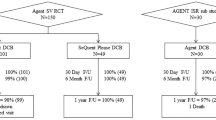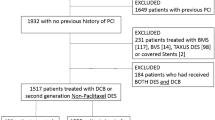Abstract
Drug-coated balloon (DCB) angioplasty has been shown to be a promising option for the treatment of coronary in-stent restenosis (ISR). We compared the clinical outcomes of patients with ISR who were treated with two commonly used paclitaxel-containing DCBs, the Pantera Lux (PL) and SeQuent Please (SP). A total of 491 patients with 507 ISR lesions [PL-DCB in 127 (26%) patients and SP-DCB in 364 (74%) patients] underwent DCB angioplasty for ISR lesions. The major adverse cardiac events (MACEs), including cardiac death, target lesion-related myocardial infarction, and target lesion revascularization, were assessed. There were no significant differences in each occurrence of MACE and cardiac death: 16 MACEs (61 per 1000 person-years) in the PL-DCB group and 55 (60 per 1000 person-years) MACEs in the SP-DCB group, log-rank p = 0.895, and three cardiac deaths (11 per 1000 person-years) in the PL-DCB group and ten cardiac deaths (11 per 1000 person-years) in the SP-DCB group, log-rank p = 0.849. Diabetes mellitus under insulin treatment [hazard ratio (HR) 2.71; 95% confidence interval (CI) 1.31–5.60; p = 0.007], chronic kidney disease (HR 1.99; 95% CI 1.01–3.92; p = 0.045), early-onset ISR (HR 1.99; 95% CI 1.18–3.36; p = 0.010), and recurrent ISR (HR 1.89; 95% CI 1.08–3.32; p = 0.026) were associated with the occurrence of MACE after DCB angioplasty. There was no significant difference of MACE between PL-DCB and SP-DCB treatment in patients with ISR. Patients with insulin-treated diabetes, chronic kidney disease, early-onset ISR, and recurrent ISR were at a higher risk of MACE after DCB angioplasty.




Similar content being viewed by others
References
Giacoppo D, Gargiulo G, Aruta P, Capranzano P, Tamburino C, Capodanno D (2015) Treatment strategies for coronary in-stent restenosis: systematic review and hierarchical Bayesian network meta-analysis of 24 randomised trials and 4880 patients. BMJ 351:h5392
Alfonso F, Byrne RA, Rivero F, Kastrati A (2014) Current treatment of in-stent restenosis. J Am Coll Cardiol 63(24):2659–2673
Joner M, Byrne RA, Lapointe JM, Radke PW, Bayer G, Steigerwald K, Wittchow E (2011) Comparative assessment of drug-eluting balloons in an advanced porcine model of coronary restenosis. Thromb Haemost 105(5):864–872
Nijhoff F, Stella PR, Troost MS, Belkacemi A, Nathoe HM, Voskuil M, Samim M, Doevendans PA, Agostoni P (2016) Comparative assessment of the antirestenotic efficacy of two paclitaxel drug-eluting balloons with different coatings in the treatment of in-stent restenosis. Clin Res Cardiol 105(5):401–411
Hong SJ, Kim BK, Shin DH, Nam CM, Kim JS, Ko YG, Choi D, Kang TS, Kang WC, Her AY, Kim YH, Hur SH, Hong BK, Kwon H, Jang Y, Hong MK (2015) Effect of intravascular ultrasound-guided vs angiography-guided everolimus-eluting stent implantation: the IVUS-XPL randomized clinical trial. JAMA 314(2):2155–2163
Cutlip DE, Windecker S, Mehran R, Boam A, Cohen DJ, van Es GA, Steg PG, Morel MA, Mauri L, Vranckx P, McFadden E, Lansky A, Hamon M, Krucoff MW, Serruys PW (2007) Clinical end points in coronary stent trials: a case for standardized definitions. Circulation 115(17):2344–2351
Curtis LH, Hammill BG, Eisenstein EL, Kramer JM, Anstrom KJ (2007) Using inverse probability-weighted estimators in comparative effectiveness analyses with observational databases. Med Care 45:S103–107
Kurth T, Walker AM, Glynn RJ, Chan KA, Gaziano JM, Berger K, Robins JM (2006) Results of multivariable logistic regression, propensity matching, propensity adjustment, and propensity-based weighting under conditions of nonuniform effect. Am J Epidemiol 163:262–270
Benjamini Y, Hochberg Y (1995) Controlling the false discovery rate: a practical and powerful approach to multiple testing. J R Stat Soc Series B Stat Methodol 57(1):289–300
Wei LJ, Lin DY, Weissfeld L (1989) Regression analysis of multivariate incomplete failure time data by modeling marginal distributions. J Am Stat Assoc 84(408):1065–1073
Gongora CA, Shibuya M, Wessler JD, McGregor J, Tellez A, Cheng Y, Conditt GB, Kaluza GL, Granada JF (2015) Impact of paclitaxel dose on tissue pharmacokinetics and vascular healing: a comparative drug-coated balloon study in the familial hypercholesterolemic swine model of superficial femoral in-stent restenosis. JACC Cardiovasc Interv 8(8):1115–1123
Meenasree B, Poorna Jyothi R, Mukty S (2018) Drug-eluting balloon: design, technology and clinical aspects. Biomed Mater 13(3):032001
Cheng Y, Leon MB, Granada JF (2016) An update on the clinical use of drug-coated balloons in percutaneous coronary interventions. Expert Opin Drug Deliv 13:859–872
Stella PR, Belkacemi A, Agostoni P (2010) Drug-eluting balloons and bifurcations: A new future? EuroIntervention 6(Suppl J):J161–164
Joner M, Radke PW, Byrne RA, Hartwig S, Steigerwald K, Leclerc G, Wittchow E (2012) Preclinical evaluation of a novel drug-eluting balloon in an animal model of in-stent stenosis. J Biomater Appl 27(6):717–726
Fernández-Parra R, Laborda A, Lahuerta C, Lostalé F, Aramayona J, de Blas I, de Gregorio MA (2015) Pharmacokinetic study of paclitaxel concentration after drug-eluting balloon angioplasty in the iliac artery of healthy and atherosclerotic rabbit models. J Vasc Interv Radiol 26(9):1380–1387.e1381
El-Hayek G, Bangalore S, Casso Dominguez A, Devireddy C, Jaber W, Kumar G, Mavromatis K, Tamis-Holland J, Samady H (2017) Meta-analysis of randomized clinical trials comparing biodegradable polymer drug-eluting stent to second-generation durable polymer drug-eluting stents. JACC Cardiovasc Interv 10(5):462–473
Bajraktari G, Jashari H, Ibrahimi P, Alfonso F, Jashari F, Ndrepepa G, Elezi S, Henein MY (2016) Comparison of drug-eluting balloon versus drug-eluting stent treatment of drug-eluting stent in-stent restenosis: a meta-analysis of available evidence. Int J Cardiol 218:126–135
Lee JM, Park J, Kang J, Jeon K-H, J-h J, Lee SE, Han J-K, Kim H-L, Yang H-M, Park KW, Kang H-J, Koo B-K, Kim H-S (2015) Comparison among drug-eluting balloon, drug-eluting stent, and plain balloon angioplasty for the treatment of in-stent restenosis. a network meta-analysis of 11. Randomized, Controlled Trials JACC Cardiovasc Interv 8(3):382–394
Colleran R, Joner M, Kufner S, Altevogt F, Neumann FJ, Abdel-Wahab M, Bohner J, Valina C, Richardt G, Zrenner B, Cassese S, Ibrahim T, Laugwitz KL, Schunkert H, Kastrati A, Byrne RA (2018) Comparative efficacy of two paclitaxel-coated balloons with different excipient coatings in patients with coronary in-stent restenosis: a pooled analysis of the intracoronary stenting and angiographic results—optimizing treatment of drug eluting stent in-stent restenosis 3 and 4 (ISAR-DESIRE 3 and ISAR-DESIRE 4) trials. Int J Cardiol 252:57–62
Assadi-Schmidt A, Mohring A, Liebsch E, Dannenberg L, Achilles A, Pöhl M, Afzal S, Veulemans V, Horn P, Sansone R, Bönner F, Levkau B, Kelm M, Zeus T, Polzin A (2017) SeQuent Please vs. Pantera Lux drug coated balloon angioplasty in real life: results from the Düsseldorf DCB registry. Int J Cardiol 231:68–72
Kawamoto H, Ruparelia N, Latib A, Miyazaki T, Sato K, Mangieri A, Contri R, Stella S, Figini F, Chieffo A, Carlino M, Montorfano M, Colombo A (2015) Drug-coated balloons versus second-generation drug-eluting stents for the management of recurrent multimetal-layered in-stent restenosis. JACC Cardiovasc Interv 8(12):1586–1594
Scheller B, Clever YP, Kelsch B, Hehrlein C, Bocksch W, Rutsch W, Haghi D, Dietz U, Speck U, Bohm M, Cremers B (2012) Long-term follow-up after treatment of coronary in-stent restenosis with a paclitaxel-coated balloon catheter. JACC Cardiovasc Interv 5(3):323–330
Xu B, Gao R, Ja W, Yang Y, Chen S, Liu B, Chen F, Li Z, Han Y, Fu G, Zhao Y, Ge J (2014) A prospective, multicenter, randomized trial of paclitaxel-coated balloon versus paclitaxel-eluting stent for the treatment of drug-eluting stent in-stent restenosis: results From the PEPCAD China ISR trial. JACC Cardiovasc Interv 7(2):204–211
Habara S, Kadota K, Shimada T, Ohya M, Amano H, Izawa Y, Kubo S, Hyodo Y, Otsuru S, Hasegawa D, Tada T, Tanaka H, Fuku Y, Goto T, Mitsudo K (2015) Late restenosis after paclitaxel-coated balloon angioplasty occurs in patients with drug-eluting stent restenosis. J Am Coll Cardiol 66(1):14–22
Takagi T, Yoshida K, Akasaka T, Kaji S, Kawamoto T, Honda Y, Yamamuro A, Hozumi T, Morioka S (2000) Hyperinsulinemia during oral glucose tolerance test is associated with increased neointimal tissue proliferation after coronary stent implantation in nondiabetic patients: a serial intravascular ultrasound study. J Am Coll Cardiol 36(3):731–738
Takagi T, Akasaka T, Yamamuro A, Honda Y, Hozumi T, Morioka S, Yoshida K (2002) Impact of insulin resistance on neointimal tissue proliferation after coronary stent implantation. Intravascular ultrasound studies. J Diabetes Complicat 16(1):50–55
Komatsu T, Yaguchi I, Komatsu S, Nakahara S, Kobayashi S, Sakai Y, Taguchi I (2015) Impact of insulin resistance on neointimal tissue proliferation after 2nd-generation drug-eluting stent implantation. Tex Heart Inst J 42(4):327–332
Breen DM, Chan KK, Dhaliwall JK, Ward MR, Al Koudsi N, Lam L, De Souza M, Ghanim H, Dandona P, Stewart DJ, Bendeck MP, Giacca A (2009) Insulin increases reendothelialization and inhibits cell migration and neointimal growth after arterial injury. Arterioscler Thromb Vasc Biol 29(7):1060–1066
Guo J, Dhaliwall JK, Chan KK, Ghanim H, Al Koudsi N, Lam L, Madadi G, Dandona P, Giacca A, Bendeck MP (2013) In vivo effect of insulin to decrease matrix metalloproteinase-2 and -9 activity after arterial injury. J Vasc Res 50(4):279–288
Chiang S, Breen DM, Guo J, Mori Y, Giacca A (2013) Local insulin application on the carotid artery inhibits neointima formation. Can J Physiol Pharmacol 91(12):1086–1094
Alfonso F, Pérez-Vizcayno MJ, Hernández R, Goicolea J, Fernández-Ortı́z A, Escaned J, Bañuelos C, Fernández C, Macaya C (1999) Long-term outcome and determinants of event-free survival in patients treated with balloon angioplasty for in-stent restenosis. Am J Cardiol 83(9):1268–1270
Nakazawa G, Otsuka F, Nakano M, Vorpahl M, Yazdani SK, Ladich E, Kolodgie FD, Finn AV, Virmani R (2011) The pathology of neoatherosclerosis in human coronary implants: bare-metal and drug-eluting stents. J Am Coll Cardiol 57(11):1314–1322
Funding
This study was supported by a grant from the Korea Healthcare Technology Research and Development Project, Ministry for Health and Welfare, Republic of Korea (Nos. A085136 and HI15C1277), the Mid-Career Research Program through a NRF grant funded by the NEST, Republic of Korea (No. 2015R1A2A2A01002731), and the Cardiovascular Research Center, Seoul, Korea.
Author information
Authors and Affiliations
Corresponding author
Ethics declarations
Conflict of interest
The author declares that they have no conflict of interest.
Additional information
Publisher's Note
Springer Nature remains neutral with regard to jurisdictional claims in published maps and institutional affiliations.
Rights and permissions
About this article
Cite this article
Nguyen, V.P.T., Kim, C., Hong, SJ. et al. Comparison of clinical outcomes of two different types of paclitaxel-coated balloons for treatment of patients with coronary in-stent restenosis. Heart Vessels 34, 1420–1428 (2019). https://doi.org/10.1007/s00380-019-01388-z
Received:
Accepted:
Published:
Issue Date:
DOI: https://doi.org/10.1007/s00380-019-01388-z




